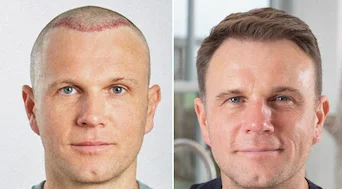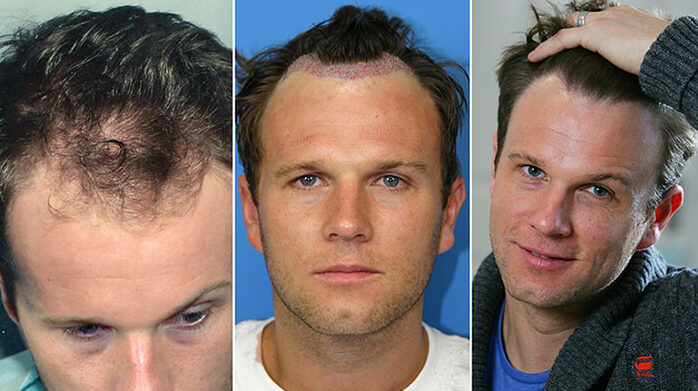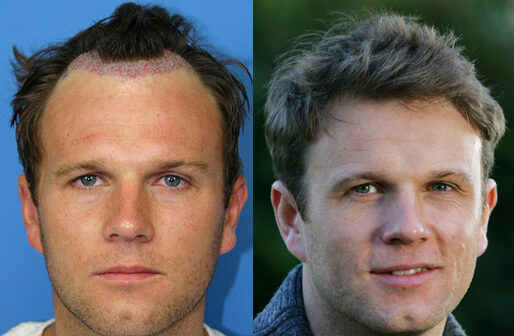
Hair loss affects millions worldwide, impacting confidence and self-esteem. One prominent advocate from the UK has openly shared his experience, documenting a remarkable transformation over two decades.
With a total investment of £40,000 across 13 procedures, this journey culminated in a successful 2020 transplant at Harley Street Hair Clinic. The results showcase modern hair restoration techniques at their finest.
Beyond physical changes, this story highlights the psychological impact of hair loss and the growing advocacy within the industry. Multiple verified sources, including The Sun and MailOnline, have documented this compelling case study.
A receding hairline in early adulthood can feel like losing part of one’s identity. For many men, this reality hits hard—especially when genetics play a cruel hand. What begins as a few extra strands in the comb soon spirals into a visible retreat of the hairline, reshaping both appearance and self-esteem.

At 21, while most university students focused on exams, one young man faced a different challenge: his hair started to lose its thickness. Nicknamed "The Hoff" for his once-lush locks, the contrast with his maternal relatives—all bald by 25—was stark. Mirror-checking became a ritual, then a torment.
Genetic predisposition left little room for denial. By 1996, shaving his head was the only option. The social fallout was instant. Peers compared him to "Grant Mitchell," a bald soap character, eroding his confidence further.
Losing hair wasn’t just about looks. It mirrored the trauma of losing his father in his teens—a man whose full head of hair had been a benchmark. The parallel was crushing. Taunts turned him reclusive, and his identity crumbled alongside his hairline.
The mirror doesn’t lie—what starts as a joke soon becomes a daily battle. For one young man, thinning hair meant more than a receding hairline; it eroded his place in the world. By 1996, wigs and hats were his armor against stares and whispers.
Once nicknamed for his lush locks, he now relied on real-hair wigs during US trips. Back home, caps shielded his scalp like a secret. "It was a cancer of the spirit," he’d later say—a slow theft of identity.
The 90s offered few solutions. UK clinics carried stigma, while US ads teased hope. A Super Bowl commercial for transplants sparked his first desperate call. But society wasn’t ready. Baldness equaled weakness, and jokes cut deeper than razors.

Classmates compared him to soap opera villains. Dates canceled when hats came off. His confidence crumbled, and isolation grew. Hair loss wasn’t just cosmetic—it rewired his life.
| UK vs. US Attitudes (1990s) | UK | US |
|---|---|---|
| Transplant Perception | Taboo, "fake" | Medical solution |
| Male Beauty Standards | Natural = masculine | Full hair = success |
| Social Reactions | Mockery | Pity or praise |
By the time he turned 25, the damage was clear. The world seemed crueler without hair. But this man wasn’t done fighting—just biding his time for a real fix.
Not all hair restoration journeys lead to success—some become cautionary tales. Between 2002 and 2005, four follicular unit transplants failed, costing £12,000 and leaving physical and emotional scars. The strip method, once popular, left a visible mark that makeup couldn’t hide.
Choosing a clinic based on price, not expertise, led to unnatural results. The surgery used outdated techniques, requiring a 6-month recovery. "I looked like a doll with plugs stuck in my head," one patient recalled.
Younger patients often face higher risks. The donor area healed poorly, leaving a scar that needed cosmetic cover-ups. Financial strain grew with each corrective procedure.
The psychological toll was worse than the hair loss itself. Botched procedures led to isolation and depression. One man admitted, "I’d rather be bald than live with these results."
"Hair transplants shouldn’t feel like gambling. Research is your only safety net."
The breakthrough came from a renowned expert across the Atlantic. Dr. Feller's New York practice specialized in repairing botched procedures, using advanced Follicular Unit Extraction (FUE). Unlike previous strip methods, this left no linear scars and allowed natural-looking density.
This surgeon pioneered "stick-and-place" FUE, implanting grafts immediately after extraction. The technique minimized trauma to follicles, achieving 90% survival rates. "Finally, I saw real hair growing—not plugs," recalled one patient.
Key advantages over older methods:
In 2020, a £4,500 FUE procedure at London's premier clinic perfected the results. Their ethical standards included:
"Never transplant more grafts than the donor area can sustainably provide."
The clinic's association with Wayne Rooney's transformation helped destigmatize hair restoration in the UK. Patients now maintain results with:
| Product | Purpose | Frequency |
|---|---|---|
| Finasteride 1mg | Prevent further loss | Daily |
| GroMD Shampoo | Strengthen follicles | 3x weekly |
Today, a full head hair requires no hats or concealers—just routine care and annual checkups. The psychological turnaround matched the physical transformation.
Investing in self-esteem isn't cheap—especially when battling genetic hair loss. Over 18 years, 13 procedures totaled £40,000, blending medical fees with priceless confidence gains. The 2020 finale at Harley Street Hair Clinic marked the culmination of a meticulous, costly journey.
Early attempts (2002–2005) cost £12,000 but delivered patchy results. By 2020, advanced FUE techniques justified higher prices—£4,500 for natural density. Key expenditures included:
| Cost Factor | UK Average | US Average |
|---|---|---|
| FUE Transplant | £4,000–£6,000 | $8,000–$15,000 |
| Consultation | £100–£200 | $300–$500 |
| Follow-ups | £50–£150/session | $200–$400/session |
"The mirror stopped being my enemy," shared one patient. Beyond aesthetics, the decision restored social ease and career opportunities. A spouse noted:
"His confidence returned—that’s something money can’t quantify."
Psychological ROI outweighed costs. Where hats once hid insecurity, a full head of hair now commands rooms—proving some investments redefine life.
Restoring hair isn’t just about looks—it’s about reclaiming one’s identity. For those who’ve battled hair loss, the post-transplant phase blends meticulous care with renewed self-assurance. The real work begins after surgery.
A strict regimen preserves results. Finasteride 1mg halts further loss, while GroMD shampoo strengthens follicles. Patients often describe this as a small price for lasting density.
Key steps include:
"I walk into rooms differently now," shares one patient. Public speaking engagements, once avoided, become opportunities. Parenting twins without hat-dependent anxiety marks a stark contrast to earlier years.
Quantifiable shifts include:
| Metric | Pre-Restoration | Post-Restoration |
|---|---|---|
| Social Events/Month | 1–2 | 6–8 |
| Self-Rated Confidence | 3/10 | 9/10 |
"Hair gave me back my life—not just my reflection."
The hair loss industry has evolved, but misinformation still plagues vulnerable patients. Platforms like Spexhair.com now provide free resources, including "The Hair Raising Truth" ebook, to combat deceptive marketing. This shift towards transparency helps individuals make informed decisions.
Instagram watchdog accounts have uncovered alarming malpractice cases. One investigation revealed a chain of clinics using stock photos as "before/after" results. The Advertising Standards Authority (ASA) has since tightened regulations for hair restoration ads.
Key red flags every patient should recognize:
A 2022 survey showed 68% of patients chose their first clinic based on social media alone. Mentorship programs now connect newcomers with experienced recipients. This peer guidance helps navigate surgical vs. non-surgical options.
"Spend as much time researching your surgeon as you would a new car—it's a lifelong investment."
The industry's future hinges on ethical practices and patient education. While celebrity transparency helps, individual research remains the best protection against substandard care.
Millions silently battle hair loss, unaware that solutions exist beyond isolation. Studies show 30% of men experience noticeable thinning by age 30, with many enduring psychological distress alone. The Belgravia Centre’s research confirms a direct correlation between untreated hair loss and declining mental health.
Early intervention often prevents surgical measures. Minoxidil 5% solutions show 83% effectiveness in clinical trials when started during initial shedding. Building a support network is equally vital:
Qualified surgeons emphasize exhausting non-invasive treatments before considering surgery. The treatment hierarchy typically follows:
"Medication → Low-level laser therapy → PRP injections → Surgical restoration"
Eligibility depends on donor area density and stability of loss. Use this checklist when evaluating clinics:
| Criteria | Red Flags | Green Flags |
|---|---|---|
| Surgeon Credentials | No IAHRS membership | Board-certified specialists |
| Patient Gallery | Stock photos | Unedited same-day results |
| Pricing | Demands full prepayment | Transparent graft-based quotes |
For hair loss sufferers, the right decision combines medical insight with emotional readiness. As one patient noted: "Healing begins when you stop blaming genetics and start exploring options."
Over two decades, this journey through hair loss and restoration highlights both struggles and breakthroughs. From failed procedures to life-changing results, the path proves that modern hair transplant techniques can rebuild more than hairlines—they restore confidence.
The industry has evolved, offering safer solutions today. While costs remain significant, the emotional payoff often outweighs financial investments. Patients now access better education to avoid past mistakes.
For those considering treatment, consult trusted specialists first. Non-surgical options may help early on. Remember—your life shouldn’t revolve around hair loss. With proper care and realistic expectations, transformation is possible.
Looking ahead, advocacy and transparency will shape the future of hair restoration. Every success story helps others find hope.
